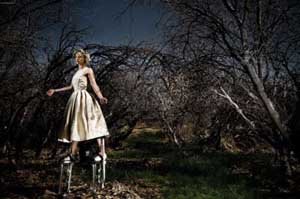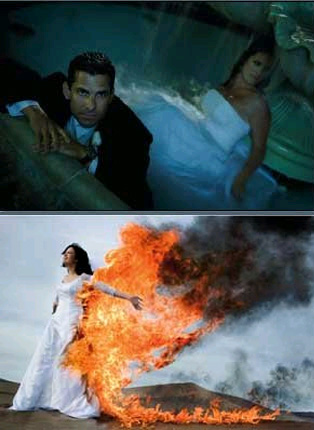articles/Weddings/lettherelight-page2
Let there be light! - part 2 of 1 2
by Terry Hansen Published 01/06/2008

The spawn of ideas.
Motivation and ideas are often found in art books or museum galleries. John Michael Cooper studied, conceptualized and recreated John Singer Sargent's 'El Jaleo' circa 1882 during a wedding reception in December 2006. Under-lighting his bride as she danced with a mariachi band behind her. This idea had been in his mind for months - he waited for the right moment and opportunity and put into motion a great scene with simple direction for his bride. (See image [2]) John still uses this under lighting technique during most receptions for unique dance shots.
Keep your mind open for possibilities. Cooper has found inspiration in fashion magazines, movies and even music videos. One of his most recent anti-bridals features a bride on stilts (image [3]). This idea spawned from an old Marilyn Manson video, which Cooper had seen several times before, but it was only recently that his idea came to mind.
Probably the most recognized image is the remake of 'Joan or Arc' recreated in the Nevada desert on a spring day in 2006. (Image [4]) Though Cooper had several volunteers, ideas and inputs when mentioning this concept to clients, there was something about this bride that 'ignited a spark'. Cooper is often heard explaining, 'the bride is in the dress and the dress is on fire, just not at the same time'. This was an actual bride who willfully posed in the dress to be photographed but was not hesitant to step out of the dress and fill it with a doll for it to be engulfed rapidly by flames.

Another well-known image is Cooper's recreation of 'Ophelia' from Hamlet (image [5]). Prior to this shoot, another bride, who had heard the idea, stepped into a running stream during her reception, hoping to be Ophelia. Though great images were captured, it just was not right - not according to Cooper. Finally, the opportunity came knocking during a winter bridal session on a private property on Mount Charleston, near Las Vegas. The water was somewhere near 40 degrees but the client was still willing. In the first attempt, she managed to stay in the water for about 30 seconds. As she tried to warm up, she apologized profusely that she couldn't stay in longer the first time in which Cooper explained that he had captured the shot he wanted. After a few moments, she insisted that she try again. The second time, she was able to stay in for a full minute and a half before her lips turned a pristine shade of blue and she began loosing feeling in her legs. Cooper never told her that he had captured the image that he wanted in the first attempt.
Soon after, a client who had diligently followed John's work wanted to recreate this image by eagerly stepping into a hotel fountain on her wedding day. Unknown to her, John never recreates his own images but is always willing to offer an alternative. (Image [6]) It was the groom who was hesitant this time in the cold water.
The 'Trash the Dress' phenomenon took off when Louisiana based photographer, Marc Erik, read an online article written by John Michael Cooper featured on wedshooter.com in February 2006. (Reference: http://www.wedshooter . com/2006/02/10/show-offaka-trashing-the-dress) and created a website called trashthedress.com, crediting John Michael Cooper as the 'Godfather of Dress Trashing'. It wasn't long before the New York Times picked it up and published a colour article in the Sunday newspaper, June 2007. From there, the way brides look at their dress has not been the same. The biggest misconception about Cooper's conceptual photography? It's never about the dress. In some concepts, the dress has become a casualty, but it is never Cooper's intentions to actually destroy a dress. There are several other ideas drawn out in a sketchbook that Cooper carries with him. He is just waiting for the right moment, subject and location to execute his ideas.
Please Note:
There is more than one page for this Article.
You are currently on page 2 Contact Terry Hansen
1st Published 01/06/2008
last update 09/12/2022 14:55:45
More Weddings Articles
There are 17 days to get ready for The Society of Photographers Convention and Trade Show at The Novotel London West, Hammersmith ...
which starts on Wednesday 14th January 2026





